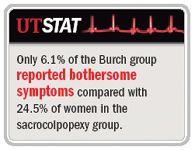Article
Prophylactic Burch suspension aids post-op continence
Maywood, IL-The addition of a standard four-stitch Burch suspension to the standard sacrocolpopexy surgical procedure in continent women with pelvic organ prolapse produces dramatic reductions in postoperative stress incontinence, according to a large multicenter study directed by physicians at the Loyola University Medical Center. Results of the trial comparing sacrocolpopexy with and without the Burch suspension were sufficiently dramatic to cause the trial directors to stop enrollment at the first interim analysis.
Maywood, IL-The addition of a standard four-stitch Burch suspension to the standard sacrocolpopexy surgical procedure in continent women with pelvic organ prolapse produces dramatic reductions in postoperative stress incontinence, according to a large multicenter study directed by physicians at the Loyola University Medical Center. Results of the trial comparing sacrocolpopexy with and without the Burch suspension were sufficiently dramatic to cause the trial directors to stop enrollment at the first interim analysis.

"I have personally stopped using urodynamics to predict which continent women need a continence procedure at the time of sacrocolpopexy. I now recommend that stress-continent patients have a Burch procedure at the time of their sacrocolpopexy," lead author Linda Brubaker, MD, MS, professor of obstetrics and gynecology at Loyola, told Urology Times.

"Only about 25% of the patients with prolapse met study criteria, meaning that they did not have symptoms of stress incontinence. That was another important finding. Many think that women with advanced prolapse do not have incontinence. We found that idea is wrong," Dr. Brubaker said.
The study involved 322 women who were candidates for surgery to correct stage II, III, or IV prolapse, but who did not have stress incontinence symptoms (Control Clin Trials 2003; 24:629-42). They were randomized to a sacrocol-popexy alone or sacrocolpopexy with the Burch suspension. Surgeons did not know which procedures were to be performed until the patient had been anesthetized, at which time the surgeon would open a sealed envelope that specified the procedure to be conducted.
Symptoms reduced
At 3 months after surgery, 23.8% of the women who received a Burch suspension exhibited one or more symptoms of stress incontinence compared with 44.1% of those women who received sacrocol-popexy alone.
Only 6.1% of the Burch group reported "bothersome" symptoms compared with 24.5% of women in the sacrocol-popexy group. Addition of the Burch procedure added about 20 minutes to the sacrocolpopexy and resulted in a loss of an additional 73 mL of blood.
Dr. Brubaker related that she had been thinking about the problem of urinary incontinence following sacrocolpopexy for nearly 10 years.
"It is a well-known problem. It breaks your heart every time you complete a beautiful prolapse repair and the patient becomes quite wet and quite miserable and associates it with the surgery," Dr. Brubaker said.
She explained that surgeons have three options for treating patients with prolapse: Perform the prolapse repair and add the suspension as a prophylactic procedure; perform the prolapse repair and anticipate that a certain percentage of the women eventually will need another operation to resolve incontinence; or perform urodynamic testing to determine which patients will be most likely to develop postoperative incontinence.
Dr. Brubaker said she was not enthusiastic about putting her patients through the rigors of urodynamic testing and did not feel the results of such tests were as predictive of subsequent incontinence as she would like. Hence, the study included the effort to evaluate the role of urodynamic testing to determine who needed prophylactic incontinence procedures.
She noted that the study's findings were limited to women undergoing abdominal sacrocolpopexy in conjunction with Burch colposuspension, and that they do not apply to other continence operations or to other prolapse repairs. Women in the study continue to be observed in follow-up. At present, the procedure has shown to significantly reduce the incidence of postoperative stress incontinence in selected women.
The study was supported in part by a grant from the National Institute of Child Health and Human Development.




